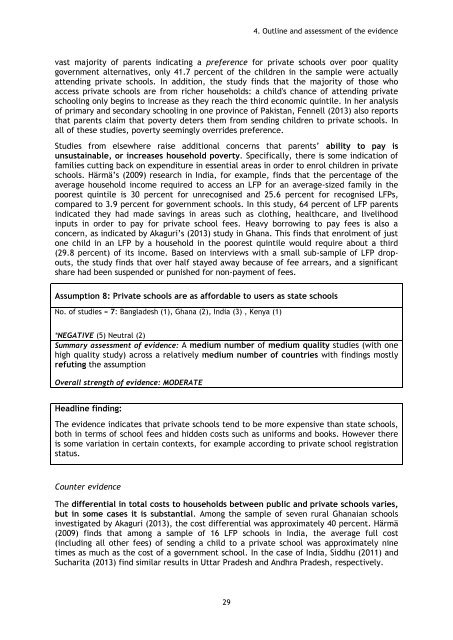private-schools-full-report
private-schools-full-report
private-schools-full-report
You also want an ePaper? Increase the reach of your titles
YUMPU automatically turns print PDFs into web optimized ePapers that Google loves.
4. Outline and assessment of the evidence<br />
vast majority of parents indicating a preference for <strong>private</strong> <strong>schools</strong> over poor quality<br />
government alternatives, only 41.7 percent of the children in the sample were actually<br />
attending <strong>private</strong> <strong>schools</strong>. In addition, the study finds that the majority of those who<br />
access <strong>private</strong> <strong>schools</strong> are from richer households: a child's chance of attending <strong>private</strong><br />
schooling only begins to increase as they reach the third economic quintile. In her analysis<br />
of primary and secondary schooling in one province of Pakistan, Fennell (2013) also <strong>report</strong>s<br />
that parents claim that poverty deters them from sending children to <strong>private</strong> <strong>schools</strong>. In<br />
all of these studies, poverty seemingly overrides preference.<br />
Studies from elsewhere raise additional concerns that parents’ ability to pay is<br />
unsustainable, or increases household poverty. Specifically, there is some indication of<br />
families cutting back on expenditure in essential areas in order to enrol children in <strong>private</strong><br />
<strong>schools</strong>. Härmä’s (2009) research in India, for example, finds that the percentage of the<br />
average household income required to access an LFP for an average-sized family in the<br />
poorest quintile is 30 percent for unrecognised and 25.6 percent for recognised LFPs,<br />
compared to 3.9 percent for government <strong>schools</strong>. In this study, 64 percent of LFP parents<br />
indicated they had made savings in areas such as clothing, healthcare, and livelihood<br />
inputs in order to pay for <strong>private</strong> school fees. Heavy borrowing to pay fees is also a<br />
concern, as indicated by Akaguri’s (2013) study in Ghana. This finds that enrolment of just<br />
one child in an LFP by a household in the poorest quintile would require about a third<br />
(29.8 percent) of its income. Based on interviews with a small sub-sample of LFP dropouts,<br />
the study finds that over half stayed away because of fee arrears, and a significant<br />
share had been suspended or punished for non-payment of fees.<br />
Assumption 8: Private <strong>schools</strong> are as affordable to users as state <strong>schools</strong><br />
No. of studies = 7: Bangladesh (1), Ghana (2), India (3) , Kenya (1)<br />
*NEGATIVE (5) Neutral (2)<br />
Summary assessment of evidence: A medium number of medium quality studies (with one<br />
high quality study) across a relatively medium number of countries with findings mostly<br />
refuting the assumption<br />
Overall strength of evidence: MODERATE<br />
Headline finding:<br />
The evidence indicates that <strong>private</strong> <strong>schools</strong> tend to be more expensive than state <strong>schools</strong>,<br />
both in terms of school fees and hidden costs such as uniforms and books. However there<br />
is some variation in certain contexts, for example according to <strong>private</strong> school registration<br />
status.<br />
Counter evidence<br />
The differential in total costs to households between public and <strong>private</strong> <strong>schools</strong> varies,<br />
but in some cases it is substantial. Among the sample of seven rural Ghanaian <strong>schools</strong><br />
investigated by Akaguri (2013), the cost differential was approximately 40 percent. Härmä<br />
(2009) finds that among a sample of 16 LFP <strong>schools</strong> in India, the average <strong>full</strong> cost<br />
(including all other fees) of sending a child to a <strong>private</strong> school was approximately nine<br />
times as much as the cost of a government school. In the case of India, Siddhu (2011) and<br />
Sucharita (2013) find similar results in Uttar Pradesh and Andhra Pradesh, respectively.<br />
29


